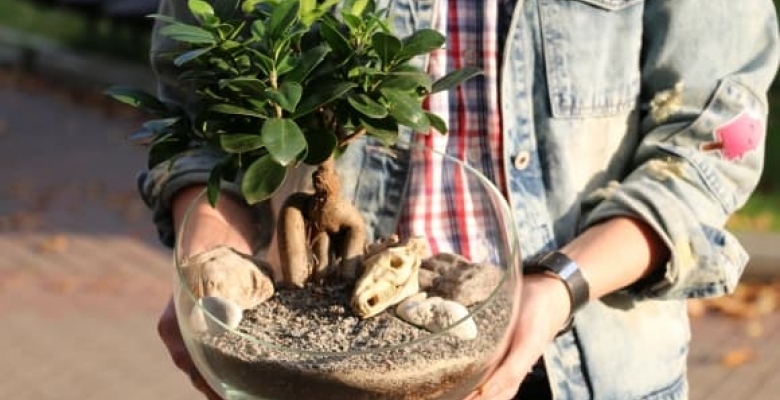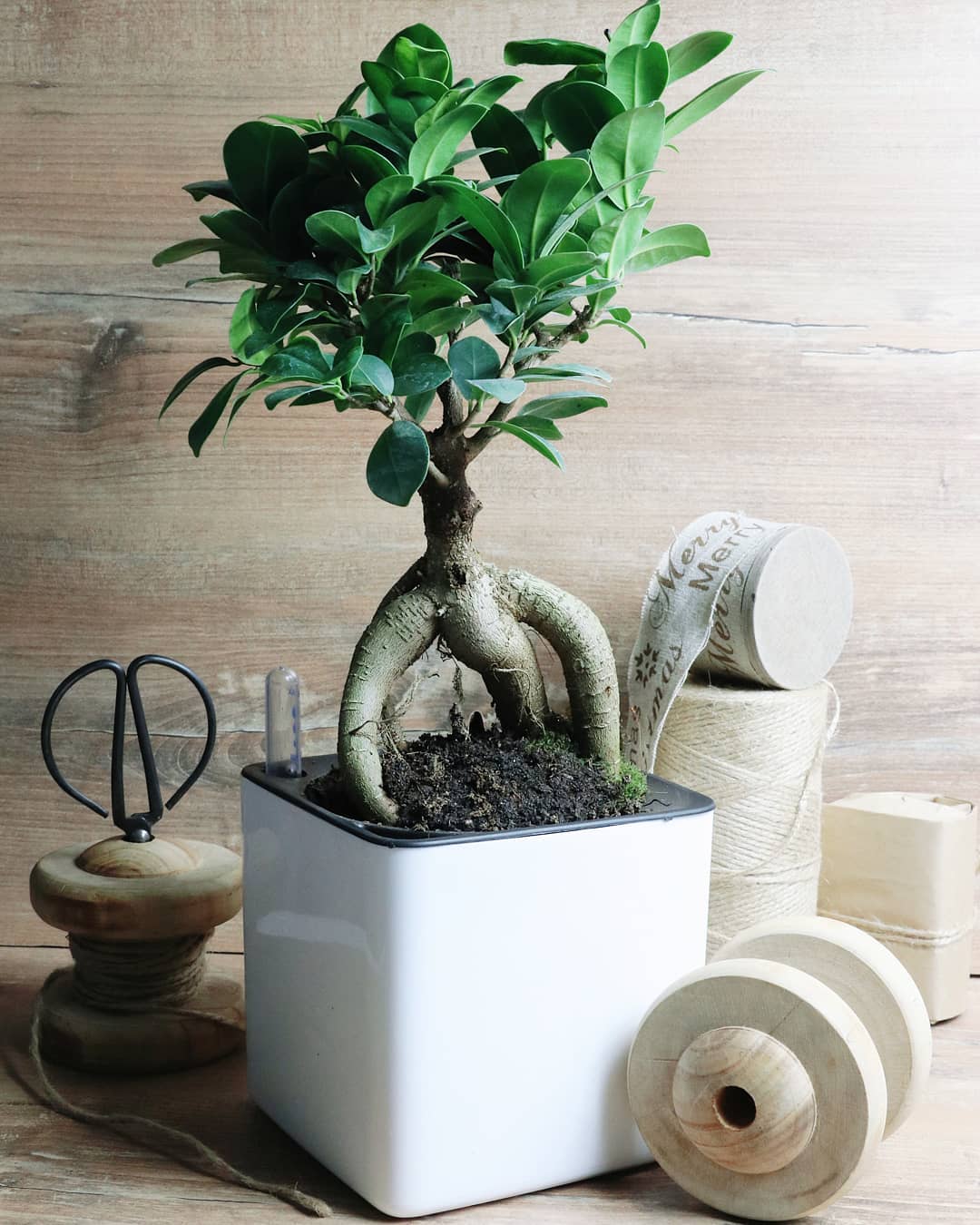
Bonsai is an ancient art that originated in Japan and gradually spread throughout the world. Its essence is the cultivation of miniature trees, which are used to decorate houses as a living and unique part of the interior.In this article You can learn How to care for bonsai at home.

A variety of plants with similar characteristics are suitable for bonsai:
- small or medium leaves;
- short internodes;
- overgrowth of roots in width, and not in depth;
- barrel flexibility;
- resistance to drought and damage;
- the ability to adapt to different conditions and recover quickly.
You can form a bonsai from any tree, but the best choice would be:
- conifers (juniper, larch, pine, spruce);
- deciduous (maple, hornbeam, elm, beech, oak, birch, apple, wisteria, ginkgo biloba, sakura, azalea);
- evergreens (Benjamin's ficus,microcarp ficus , crassula, hibiscus, myrtle, olive, zanthoxylum, small-leaved erection, myrsina , Japanese euonymus, paniculata syzygium).
A bonsai mix is also on sale, consisting of several dwarf trees of different species. Such a composition is often complemented with ferns and stones.
How to care for bonsai at home
In order for a bonsai to delight with its beauty for a long time, it is necessary to provide it with proper care.
Location and lighting
A dwarf tree requires bright lighting for at least 6 hours a day. But at the same time, direct sunlight must be avoided in order to prevent burns.
It is best to place the bonsai on the right side of the west sill or the left side of the south sill. An excellent choice would be a shelf or a coffee table near the window.
If you decide to place the tree in a dark place, then you will have to provide it with daily artificial lighting for 12 hours.
Ficus bonsai does not require additional lighting and grows well in partial shade.
The type of plant affects the temperature regime. Conifers, myrtle, pomegranate, olives need a winter temperature drop of 5-13 degrees, and the inhabitants of the tropics should maintain a temperature of 18-24 ° C all year round.
In the summer, it is advisable to take the tree out into the street, which contributes to the improvement of decorativeness.
Soil and pot
You can prepare the soil according to the type of tree or use a universal soil. But it is better to purchase a special soil for bonsai - akadama. This is the name of granular clay, which is mined in the Japanese province of Akadama. It is formed during volcanic activity. Akadama perfectly permeates air, absorbs moisture, does not stick together and does not lose shape in water.
A tiny tree is planted in a small clay pot with lots of drainage holes. The height of the container should not exceed 6 centimeters, and the width should be equal to the diameter of the crown.
How to water a bonsai
The frequency and amount of watering depends on many factors: plant species, soil type, season, location, light intensity. It is best to focus on the condition of the tree and the dryness of the soil. If the ground has dried out by 2-3 centimeters, and the tree has grown dull, then you need to water it.

But there are general rules for watering any bonsai:
- watering is carried out in the morning (in the evening, favorable conditions are created for the development of fungi, and in the afternoon, drops of water play the role of a lens, which can provoke a sunburn);
- water must be melt, rainwater or well-separated, always at room temperature;
- watering the plant both in summer and in winter, approximately every 3-4 days
- the longer the tree is in the illuminated place, the more water it needs.
Besides watering, maintaining moisture is important. To do this, the tree should be regularly sprayed. You can install a humidifier or an aquarium, or use hydro balls.
Planting and transplanting
It is important to plant the bonsai. Drainage is placed on the bottom of the pot (expanded clay, perlite, vermiculite are used for it) and part of the substrate is poured. A tree is placed in the center, the roots are completely covered with soil, moss is laid out on top. The soil is well moisturized. After 3 weeks, fertilize is applied and dry branches are removed.
Repotting is best done in the spring when the plant comes out of dormancy. Young trees are replanted annually, and old trees - every 3-5 years. In this case, the condition of the bonsai should be monitored. An emergency transplant will be required if the leaves turn yellow, the roots rot, or the root system fills the pot and begins to come out through the drainage holes. The plant is taken out of the old flowerpot, the roots are cut off by a third, cleaned of the earth and washed. For planting, use the same container or slightly more.
Root system care
The roots of miniature trees are very vulnerable and need protection from negative influences. To strengthen the soil, moss is planted on top of it, additionally serving as mulch.
Fertilizers and feeding
Due to the fact that bonsai is planted in small flowerpots, it needs regular, but limited feeding. It is best to purchase organic ball fertilizers that are made according to a Japanese recipe. They give leaves and needles a bright green color, contribute to the development of the root system and the appearance of flowers.
Not bad miniature trees react to mineral fertilizers, bone meal and fish meal.
In spring, bonsai are fed with nitrogen fertilizers, in summer with complex fertilizers, and in autumn and winter with potassium-phosphorus fertilizers.
In summer, fertilizers are applied every 2-3 weeks, and in winter - monthly. Dilute 2 grams of fertilizer in a liter of water, pour the solution into a wide bowl and place the pot with the plant in it until the water is completely absorbed.
Root top dressing is not recommended. Usually, moss is planted around the bonsai, which turns yellow when a mineral solution gets on it.
Pruning
To maintain an attractive appearance, crown formation should be carried out regularly, removing vertical shoots that "knock out" from the "green cloud". Formative pruning is best done in spring or fall, and excess leaves should be pinched off in summer.
To obtain the characteristic bonsai crown shape, it is cut radically on one side, which stimulates the growth and development of branches on the opposite side.
A young, non-lignified tree can be given any desired shape if the trunk is directed in the desired direction with a soft wire.
Diseases and pests
The most common disease is chlorosis, which causes yellowing of the leaves. It develops with a deficiency of mineral elements. Therefore, when yellow leaves appear, it is necessary to improve feeding, ensure high-quality watering and bright lighting.
Another common disease is powdery mildew. Fungi settle on the leaves, forming a white bloom. In such cases, it is necessary to remove all damaged leaves, and treat the bonsai with a fungicide.
The most common pests are aphids, scale insects and bark beetles. Aphids settle on the lower part of the leaves and suck the sap from the plant, which leads to its death. To destroy insects, wipe the leaves and trunk with cotton wool dipped in soapy water or ammonia. With a strong multiplication of parasites, they resort to the help of insecticidal preparations.
The shield provokes the formation of growths on the branches or at the base of the roots. They fight it by spraying the tree with insecticide, and the growths are removed with a needle.
If holes are found in the bark, indicating the appearance of a bark beetle, they are treated with a special agent.
Growing bonsai requires painstaking work. But if you create comfortable conditions for a tree, then it will reward with its original beauty.





.jpeg)


0 Comments
Post a Comment